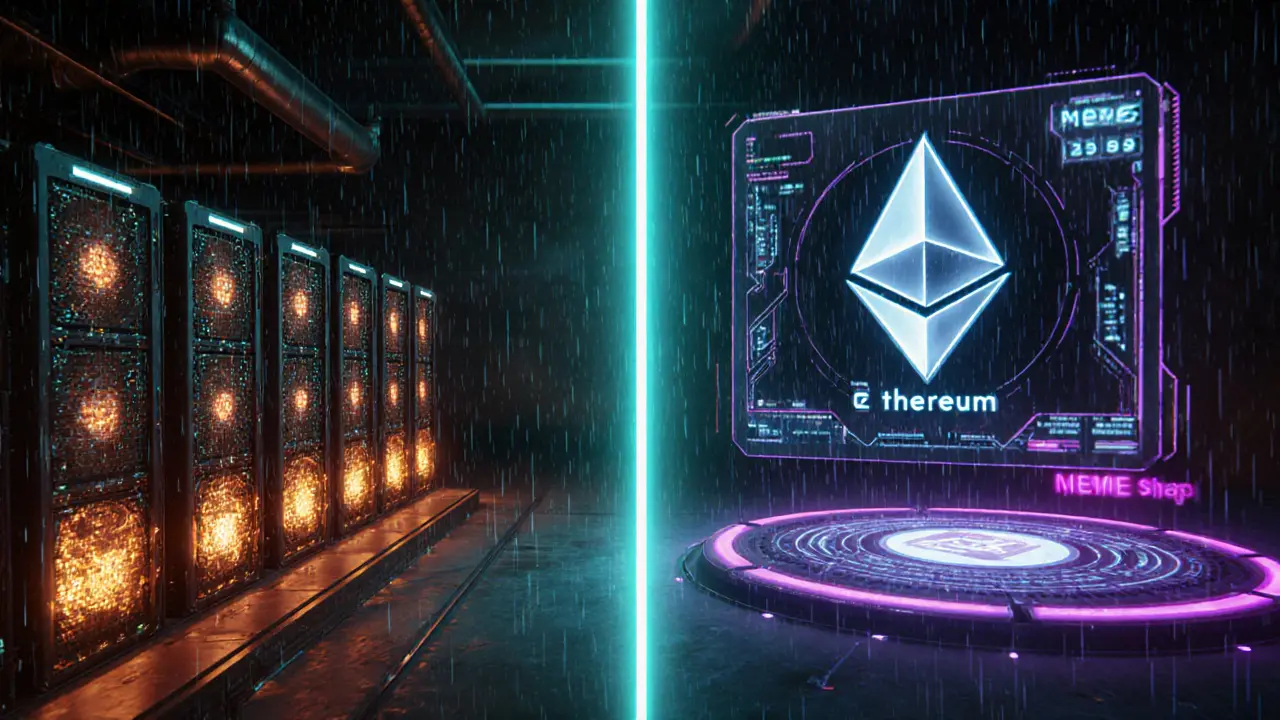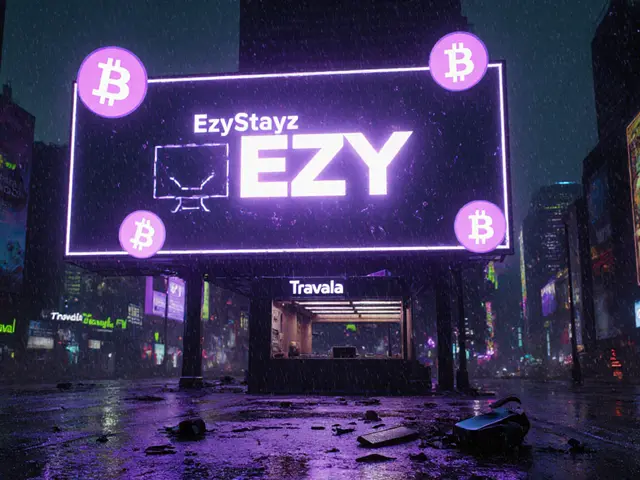MEME Token Calculator
MEME Token Information
Current Price: $0.002503 USD
Max Supply: 420.69 trillion tokens
Deflationary Mechanism: Burn + holder redistribution
*This calculator estimates potential growth based on historical deflationary mechanics and assumes consistent participation in the redistribution model.
Estimated Results
Ever wondered why a cartoon frog ended up on a blockchain? Memetic (ticker MEME) is the crypto that turned that meme into a digital asset. Launched back in 2016, it started on its own Proof‑of‑Work chain and later jumped to Ethereum as an ERC‑20 token. If you’re curious about its history, how it works, and whether it’s worth a look in 2025, keep reading.
Quick Takeaways
- MEME launched on March52016, making it one of the oldest meme‑coins.
- Originally a PoW blockchain, it migrated to Ethereum in 2023 and now follows ERC‑20 standards.
- Maximum supply is a tongue‑in‑cheek 420.69trillion tokens.
- Price hovers around $0.0025USD with 24‑hour volume near $214k.
- Deflationary mechanics and holder‑redistribution aim to reward long‑term investors.
From Pepe the Frog to a Blockchain Asset
The story starts with a simple idea: honor the internet’s most controversial amphibian. The anonymous founders created a token that paid homage to Pepe the Frog a meme character that exploded across social media in the early 2010s. By naming the coin “Memetic” and using the ticker MEME, they tapped into a ready‑made community of meme lovers.
Early adoption was driven by grassroots promotion on Telegram a messaging platform popular with crypto groups and X (formerly Twitter). Those channels still host the bulk of official announcements, making the community feel like a club rather than a corporate project.
Technical Evolution: PoW Roots to ERC‑20 Growth
Initially, MEME ran on its own Layer‑1 blockchain secured by Proof‑of‑Work (PoW). Miners could earn fresh tokens by solving hash puzzles, a model familiar from Bitcoin. The decision to switch to Ethereum the leading smart‑contract platform in 2023 was strategic. By becoming an ERC‑20 standard token format on Ethereum, MEME gained access to DeFi protocols, better liquidity, and Ethereum’s Proof‑of‑Stake (PoS) security model.
The migration required a token swap: holders sent their legacy MEME from the old chain to a smart contract that minted the same amount on Ethereum. Most community members reported a smooth experience, though a small fraction missed the nostalgic PoW vibe.
Tokenomics That Echo Meme Culture
MEME’s supply figures read like an inside joke: 420.69trillion tokens, a nod to internet slang. The token is deflationary - every transaction triggers a tiny burn and a redistribution to existing wallets. This “reflect” mechanism means long‑term holders see their balances inch upward over time, even when they aren’t actively trading.
Circulating supply data is a bit fuzzy; some trackers list it as 0 because the token contract doesn’t expose a conventional supply function after the swap. In practice, the community treats the total minted supply as the effective ceiling.
Current market data (Oct2025):
- Price: $0.002503USD (range $0.002503‑$0.002838 across exchanges)
- 24‑hour volume: $213,662USD
- Rank: #4,072 on CoinMarketCap

Community‑Driven Growth and Market Position
Unlike many meme projects that explode overnight, MEME grew organically. The anonymous team leans on community moderators in Telegram and X to share updates, answer wallet questions, and run meme contests. This hands‑on approach fosters a sense of belonging, which analysts link to higher retention rates in the meme‑coin sector.
Memetic holds a unique spot: it predates the 2020‑2022 meme‑coin boom that birthed tokens like PEPE another frog‑themed meme token. While PEPE enjoys massive hype and higher market caps, MEME leverages its veteran status and proven resilience through several bull‑ and bear‑cycles.
How to Buy, Store, and Trade MEME
Because MEME is now an ERC‑20 token, acquiring it is straightforward:
- Set up a compatible Ethereum wallet (MetaMask, Trust Wallet, or any hardware wallet that supports ERC‑20).
- Buy ETH on a major exchange (Binance, Coinbase, etc.) and transfer it to your wallet.
- Visit a decentralized exchange (Uniswap, SushiSwap) and swap ETH for MEME using the token contract address.
- Confirm the transaction, then add MEME to your wallet’s token list using the same contract address.
Centralized exchanges also list MEME under the ticker “Memetic.” Bittrex was the first to add it back in 2017, and a handful of niche platforms still support spot trading.
Risks, Red Flags, and Things to Watch
Every meme coin carries a high‑risk profile, MEME included. Here are the main concerns:
- Anonymous team: No public identities means limited accountability.
- Supply opacity: Inconsistent circulating‑supply data can confuse investors.
- Market volatility: Memecoins often swing 30‑50% in a single day.
- Regulatory exposure: Meme‑related content has drawn scrutiny in some jurisdictions.
That said, MEME’s eight‑year track record suggests it can survive market turbulence better than many one‑year projects. Keep an eye on community sentiment on Telegram and X; a sudden drop in activity often precedes price dips.
MEME vs. PEPE: Quick Comparison
| Attribute | MEME (Memetic) | PEPE |
|---|---|---|
| Launch Year | 2016 | 2023 |
| Blockchain | Ethereum (ERC‑20) after 2023 | Ethereum (ERC‑20) |
| Max Supply | 420.69trillion | 420billion |
| Deflationary Mechanism | Burn + holder redistribution | Burn only |
| Current Price (Oct2025) | $0.0025USD | $0.018USD |
| 24h Volume | ~$214k | ~$2.1M |
| Community Size (Telegram) | ~15k members | ~45k members |
Both tokens ride the meme wave, but MEME’s longevity and redistribution model give it a “steady‑growth” flavor, whereas PEPE leans more on hype‑driven spikes.
Future Outlook
Looking ahead, MEME’s success hinges on three factors:
- Community engagement: New meme trends, contests, or collaborations can reignite interest.
- DeFi integration: Yield farms or liquidity mining that accept MEME could boost utility.
- Regulatory climate: Any crackdown on meme‑related tokens would impact sentiment.
Because the token already lives on Ethereum, developers can easily build smart‑contract extensions. Expect occasional “MEME‑Boost” events where a portion of transaction fees is redirected to community‑run projects.

Frequently Asked Questions
What does MEME stand for?
MEME is the ticker symbol for Memetic, a meme‑coin that celebrates the Pepe the Frog internet meme.
Is MEME safe to store in a hardware wallet?
Yes. Since MEME is an ERC‑20 token, any hardware wallet that supports Ethereum (Ledger, Trezor) can safely hold it.
How does the redistribution mechanism work?
Each transfer burns a tiny fraction of MEME and distributes another fraction proportionally to all existing wallets. Holders automatically receive more tokens without any action.
Can I trade MEME on centralized exchanges?
A few exchanges, like Bittrex, list MEME under the ticker “Memetic.” However, most trading happens on decentralized platforms like Uniswap.
What are the main risks of investing in MEME?
Key risks include an anonymous development team, volatile price swings, possible regulatory actions against meme‑related tokens, and occasional data inconsistencies regarding supply.






Comments
13 Comments
Shanthan Jogavajjala
PEPECoin is basically a meme‑driven deflationary token that leverages community hype to burn supply and redistribute fees to holders.
Its tokenomics rely on automated burns per transaction, creating artificial scarcity.
Cindy Hernandez
Beyond the burn, the redistribution mechanism rewards long‑term holders, which can generate a positive feedback loop and sustain community engagement.
Alie Thompson
The memetic nature of PEPECoin taps into the collective internet psyche, turning jokes into financial incentives.
Their tokenomics are deliberately engineered to produce perpetual scarcity through automated burns on each transaction.
By redistributing a portion of the fees to existing holders, the protocol creates a self‑reinforcing reward loop that encourages accumulation.
However, this design also introduces a speculative feedback mechanism that can inflate prices far beyond intrinsic value.
The community‑driven meme culture that fuels the token’s popularity is inherently volatile, as sentiment can shift overnight.
From a regulatory standpoint, such projects often operate in a gray area, lacking clear compliance frameworks.
Investors should be aware that the token’s price is more correlated with meme virality than with any fundamental utility.
Moreover, the deflationary burn model, while appealing on paper, can lead to liquidity challenges as the circulating supply diminishes.
The redistribution component attempts to mitigate this by rewarding long‑term participants, yet the overall ecosystem remains fragile.
Historical precedents in meme‑coins have shown that hype cycles can collapse dramatically, leaving late entrants with significant losses.
Ethically, the promotion of such tokens raises questions about exploiting internet culture for monetary gain.
Social media amplification can create echo chambers, where newcomers are persuaded by trending hashtags rather than sound analysis.
On the other hand, the democratization of finance that meme‑coins represent allows a broader audience to engage with crypto markets.
This accessibility, however, comes with the responsibility of educating participants about the high risk involved.
In summary, while PEPECoin offers an intriguing experiment in community‑driven deflation, it should be approached with caution and a critical eye.
Prospective buyers are advised to conduct thorough due diligence and consider the possibility of total capital erosion.
Samuel Wilson
The analysis correctly highlights both the potential upside and the inherent risks associated with such deflationary meme projects.
Investors should weigh these factors carefully before allocating capital.
Rae Harris
Honestly, the whole PEPECoin hype feels like a hype‑cycle on steroids, and most of the buzz is just folks trying to cash in on the next viral meme.
Danny Locher
Sounds wild but worth a look.
Tilly Fluf
From a scholarly perspective, the token’s architecture exemplifies a novel application of cryptoeconomic incentives, yet it simultaneously underscores the volatility inherent in meme‑driven markets.
Darren R.
What a spectacular convergence of hype, greed, and algorithmic fire‑and‑forget economics, all wrapped in a glittering meme façade, that dazzles the masses, blinds the skeptics, and fuels an endless cascade of speculative fervor!
Hardik Kanzariya
I hear you; the excitement is palpable, but it’s essential to stay grounded and remember that underlying fundamentals may be thin.
Millsaps Delaine
One cannot ignore the cultural ramifications of turning a simple meme into a financial instrument, for it reshapes how value is perceived in digital societies; the allure of instant riches masks a deeper narrative of collective imagination monetized in real time.
The hyper‑inflated token price, driven by social media virality, often eclipses any genuine utility the coin might possess.
Moreover, the perpetual burn schedule, while theoretically elegant, can induce liquidity shortages, making exit strategies precarious.
Proponents argue that the redistribution to holders creates a democratized wealth‑building mechanism, yet this benefit disproportionately accrues to early adopters.
Critics contend that the entire construct rests on speculative fervor, lacking sustainable foundations.
In practice, we observe cycles of euphoric buying spurred by viral memes, followed by brutal corrections when the novelty wanes.
This pattern mirrors historical bubbles, where collective optimism overrides rational assessment.
Consequently, participants must approach such assets with a blend of curiosity and caution, recognizing both the innovative spirit and the inherent peril.
Ultimately, PEPECoin serves as a fascinating case study of meme culture intersecting with decentralized finance, highlighting both the creativity and the volatility of modern crypto ecosystems.
Investors would be well‑advised to maintain diversified portfolios and to allocate only discretionary capital to such high‑risk ventures.
Jack Fans
I think, it’s a good idea, but, watch out for the, market volatility,, it can be nasty, especially if you jump in late.
Adetoyese Oluyomi-Deji Olugunna
The meme factor alone isn’t enough to justify serious investment.
Krithika Natarajan
While acknowledging the hype, we should also consider the token’s long‑term viability.
Write a comment